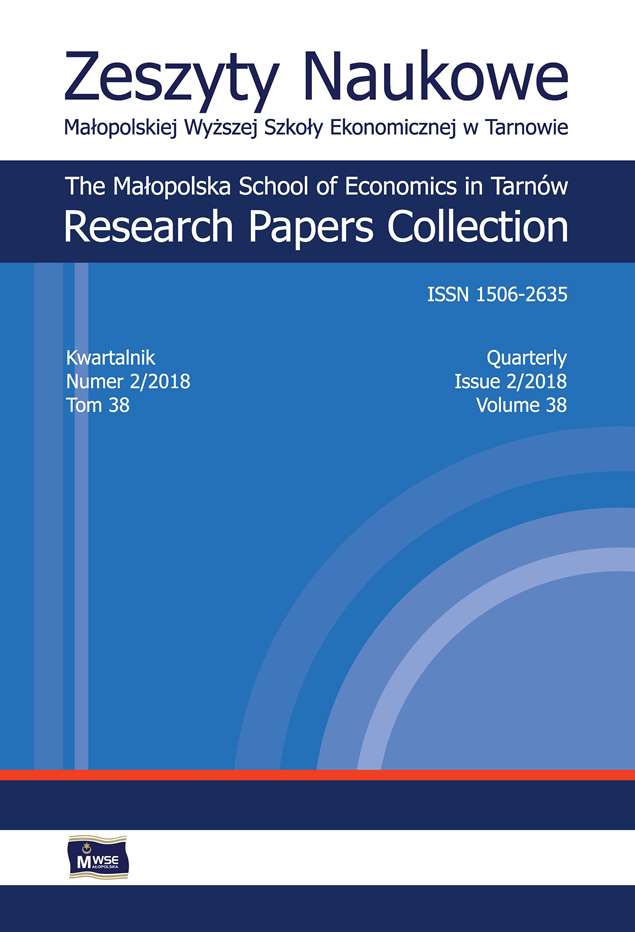Abstract
The article classifies the activities on the currency market, which are: trade and investments, speculation and striving for collateral (protection against prices changes). The factors influencing exchange rate changes were analyzed within three groups: economic, institutional and psychological. On the basis of the data, the relationships between nominal interest rates, real interest rates as well as inflation and the exchange rate of examined currency pairs were analyzed. Inflation has proved to be a strong factor weakening a given currency in the long term, which appeared to be consistent with theoretical assumptions. Higher nominal and real interest rates also showed a moderately negative correlation with the exchange rates studied under the article, which may raise some questions about compliance with the universally applicable theory. At the end of the text final considerations were made to explain the results obtained and to place them in a broader context. Limitations of the study were indicated as well.
References
Douglas, M. (2014). W transie inwestowania. Tłum. L. Sielicki. Gliwice: Helion. ISBN 9788324674176.
View in Google Scholar
Fama, E.F. (1970). Efficient capital markets: A review of theory and empirical work. The Journal of Finance, 25(2), 383–417.
View in Google Scholar
FRB. (2016). Federal Reserve Economic Data [online, dostęp: 2016-11-04]. St. Louis, MO: The Federal Reserve Bank of St. Louis. Dostępny w Internecie: https://fred.stlouisfed.org.
View in Google Scholar
Haugen, R. (1999). Nowa nauka o finansach. Przeciw efektywności rynku. Tłum. K. Środa. Warszawa: WIG-Press. ISBN 838701429X.
View in Google Scholar
Kołodziejczyk, H. (2017). Kurs walutowy, kryzys i polityka monetarna. Warszawa: CeDeWu.
View in Google Scholar
Kucharska, R. (2001). Rynek walutowy i pieniężny: wprowadzenie. Kraków: Oficyna Ekonomiczna. ISBN 8388597191.
View in Google Scholar
Lutkowski, K. (1998). Międzynarodowy system walutowy. Warszawa: Poltext. ISBN 8385366962.
View in Google Scholar
Murphy, J. (1999). Analiza techniczna rynków finansowych. Tłum. W. Madej. Warszawa: WIG-Press. ISBN 8387014222.
View in Google Scholar
Pring, M. (2006). Psychologia inwestowania. Klasyczne strategie osiągania sukcesów na giełdzie. Tłum. A. Nowińska. Kraków: Oficyna Ekonomiczna. ISBN 8388597310.
View in Google Scholar
Schwager, J. (2014). Jak naprawdę działają rynki. Fakty i mity. Tłum. M. Jania. Warszawa: Oficyna Wolters Kluwer business. ISBN 9788326443084.
View in Google Scholar
Stefański, R. (2016). Kurs walutowy jako determinanta współczesnych obrotów handlu zagranicznego. Poznań: Wydawnictwo Uniwersytetu Ekonomicznego w Poznaniu. ISBN 9788374179072.
View in Google Scholar
Stooq. (2016). Serwis internetowy [online, dostęp: 2016-11-04]. Warszawa: Stooq. Dostępny w Internecie: https://stooq.pl.
View in Google Scholar
Stopka, M. (2016). Dlaczego frank tak mocno urósł? Co wpływa na kursy walut? Jakie są teorie dotyczące kształtowania się kursów walut w krótkim i długim okresie czasu? [online, dostęp: 2016-11-04]. Dostępny w Internecie: http://www.michalstopka.pl/dlaczego-frank-tak-mocno-urosl-co-wplywa-na-kursy-walutjakie-sa-teorie-dotyczace-ksztaltowania-sie-kursow-walut-w-krotkim-i-dlugim-okresie-czasu/.
View in Google Scholar
Szyszka, A. (2009). Finanse behawioralne. Nowe podejście do inwestowania na rynku kapitałowym. Poznań: Wydawnictwo Uniwersytetu Ekonomicznego w Poznaniu. ISBN 9788374174145.
View in Google Scholar
Ward, S. (2015). Psychologia skutecznego tradingu. Tłum. R. Szymaniak. Poznań: Maklerska.pl. ISBN 9788393774388.
View in Google Scholar
Zając, J. (2005). Polski rynek walutowy w praktyce. Warszawa: K.E Liber. ISBN 8388170481.
View in Google Scholar
Zielonka, P. (2015). Giełda i psychologia. Behawioralne aspekty inwestowania na rynku papierów wartościowych. Warszawa: CeDeWu. ISBN 9788375566925
View in Google Scholar
© Copyright by Małopolska School of Economics in Tarnów. The articles are available under the Creative Commons Attribution NonCommercial-NoDerivatives 4.0 International License


